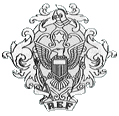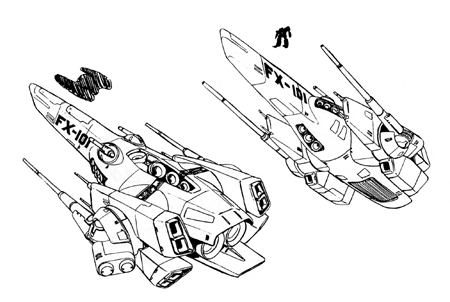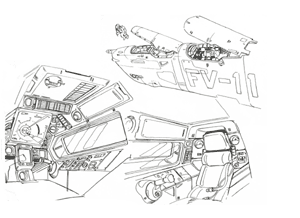

Designation: FV-11A, B Raptor Class
|

| ||||

|
|||||
The Raptor corvettes are named after carniverous animals. A total of 600 Raptor-class ships are built for the RDF on the L-5 orbital factories.
The Raptors entered service with the RDF from 2048 onwards and are still in production.

| Length | : 35.8 m over all. |
| Height | : 10.4m. |
| Width | : 21.2m. |
| Mass | : 300 metric tons (unloaded). |
The Raptor class corvettes are basically orbital defense craft with secondary atmospheric capabilities. Each FV-11 can be subdivided into four sections: nose, main body and the two side thruster/cannon assemblages. The nose contains the crew positions. The four man of the crew are located in two cockpits in tandem, each containing two man with the backs to one another. The forward cockpit seats the pilot facing forward and the offensive systems operator facing backward, the aft cockpits holds the commander in the forward seat and the defensive systems operator in the back seat. Both the pilot and the commander can pilot the craft, and the systems operators can take over each others tasks; this to ensure that the loss of one cockpit will not immobilize the craft. The nose section further contains the forward landing gear, the life support equipment, small cargo spaces and assorted electronics. The section is about two meters wide and runs 40% of the crafts' length. There are also some minor fuel tanks located here.
The main body is about 10 meters wide and high. However, the edges are sloping so the total result is a rounded rectangle. The aft part contains the two main engines, the forward part the fuel tanks, manouvering thrusters and defensive turrets. About halfway the main body are the side mountings for the auxiliary engines/cannon pods.
The side pods can rotate through 360 degrees on their mountings, so the thrusters mounted on the pods can point at any point of the vertical plane. The four particle beams are mounted on the front end of the tandem thruster assemblages, and the main mass driver cannons are mounted on yet another 360 degrees rotatable mounting on the outside of the auxiliary engines. Therefore, the main cannons do not necessarily point in the opposite direction of the auxiliary engines. The two anti-ship missile pods are mounted to the rear of the cannon assemblages, and the missiles are expelled from their launchers backwards and to the side of the ship, so that they drift clear before engine ignition.
The Raptor class corvettes are capable of planetfall and of making orbit, but as this uses up a large amount of the reaction mass, standard procedure is to base them on an orbital station and only send them to the surface for servicing and maintenance. Additionaly, the Raptor class can fight in an atmosphere, but is not really suited for it. The only scenarios in which this happens is when a Raptor chases hostile craft into an atmosphere, but prefereably these 'leakers' are left to the planetary defense forces.
After the Third Robotech War against the Invid, the Terran forces entered a large expansion program, with the aim to built a fleet capable of protecting the Earth against any known adversary. This was possible because Earth was now a protoculture producing planet, and because the Robotech Factory sattelite was repaired and in operation once more. Among the vessels produced were the Orchid class Frigates, the Valiant class Battlefortresses, the Eisenhower class heavy cruisers, the Intrepid class of light cruisers and many more. One of the designs was for a Reflex cannon intended for orbital use, functioning much like the Zentraedi Monitor class of Battlecruiser had done. However, there was also a requirement for an anti-fighter and dropship vessel, to protect the lower orbital reaches where the larger ships were too vulnerable to surface and space launched missile strikes.
Of course, so small a vessel would not be able to defend even itself against the larger ships, let alone a battlefortress, but it would, because of its larger numbers and small size, be quite effective against dropship and fighter sized enemy forces. The armament was therefore optimized against these opponents, with only a secondary capability against larger vessels.
The primary armaments of the Raptor class are its two large mass driver cannon mounted at the sides. These rapid firing cannons can destroy smaller dropships and shuttles with one salvo, and seriously damage the larger types. The two cannons are independantly rotatable of the auxiliary engines, and have a reasonable field of fire. As a secondary armament against larger starships, against which the mass driver cannons are less effective, the Raptor mounts 16 'Angel of Death' missiles. These missiles, further developments of the missiles that were so effective in the Zentraedi Holocaust, are specifically designed to penetrate starship defenses. However, all contemporary ships carry specialized defense systems against these missiles, so only in a massed attack can these missiles expect any degree of success.
The other armaments are defensive in nature. Four particle beams are mounted on the auxiliary engine pods, and typically deliver supporting fire against fighter aircraft surrounding dropships, or against the vulnerable parts of the dropships themselves. The main defensive battery consists of two laser cannon turrets. In the -A version, of which only a limited production run was made, these two turrets were mounted next to one another on top of the corvette. The tactical strategy was that this massed anti-fighter firepower in one quadrant, with the other quadrants covered by other corvettes (a typical corvette squadron has four vessels) or devoured of hostiles. It was soon recognised that a more balanced placement would increase survival chances by lessening the chances of losing both cannons to one hit, increasing the covered quadrants of singly operating corvettes and made no difference in the volume of fire of corvette formations. The -B series therefore carried one turret on the lower hull, and one turret on the upper hull. This series has entered series production, and is expected to be in service for many years to come. There are also plans to convert the -A series into -B series, as they come in for regular maintenance.
Return to Apocryphal index.
Go to Robotech Reference Guide Home Page.
Robotech (R) is the property of Harmony Gold. This document is in no way intended to infringe upon their rights.
Content by Pieter Thomassen, with Rob Morgenstern